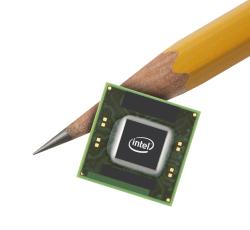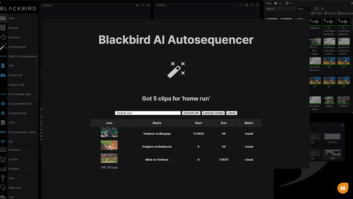
Intel has launched a new high-speed interface technology, Thunderbolt, that is perfect for editing and carries both monitor video and data, writes David Fox. The technology is a key component in Apple’s latest line-up of MacBook Pro computers.
Referred as Light Peak during development, Thunderbolt is partly based on the existing DisplayPort technology used to link computers to displays (any Mini DisplayPort display plugs directly into the Thunderbolt port). It was “specifically designed with professional audio and video applications in mind, where the inherently low latency and highly accurate time synchronisation features play a crucial role.”
It has two bi-directional channels, each with transfer speeds of up to 10Gbps, and delivers the computer’s internal PCI Express connection bus directly to external peripherals such as RAID arrays. It can support FireWire and USB consumer devices, eSATA connections, and Gigabit Ethernet networks via adapters. It should mean that transfers will rarely be limited by the connection speed, but by the speed of the drive it is connected to.
The technology was developed in collaboration with Apple, which claims it “enables expandability never before possible on a notebook computer”.
Thunderbolt supports DisplayPort connections (DisplayPort can drive greater than 1080p resolution displays and up to eight channels of audio simultaneously) and works with existing adapters for HDMI, DVI and VGA displays.
It is expected to be widely adopted as a new standard for high performance I/O, although Intel predicted that it might be 2012 before it is used by computer makers other than Apple as it is only now available as a developer kit. It apparently won’t be available as an add-in card, as it will require a new motherboard. However, disk drive manufacturers will be adding it to their products in the coming months. LaCie and Promise both showed prototype systems (the portable Little Big Disk and Pegasus 4- or 6-bay RAID respectively) using Thunderbolt at the launch, where four simultaneous uncompressed HD video streams were shown playing off the RAID.
Thunderbolt products require a controller chip supplied by Intel and a small connector. The controller chip provides protocol switching capabilities to support both protocols over a single cable. Intel is making its controller chip available now, and is working with other component manufacturers to deliver Thunderbolt connectors and cables.
“Thunderbolt is a revolutionary new I/O technology that delivers an amazing 10 gigabits per second and can support every important I/O standard which is ideal for the new MacBook Pro,” said Phil Schiller, Apple’s senior vice president of worldwide product marketing.
Various broadcast manufacturers have also announced support for the interface. For example, AJA CEO John Abt said it would enable “the fastest and simplest I/O for connecting AJA’s award-winning professional video capture and playback products” to a laptop.
Blackmagic CEO Grant Petty, meanwhile, predicted that it would “revolutionise mobile media creation. It’s a game-changer and will accelerate our ability to build the highest quality video creation products that are affordable to everyone.”
“We are very excited by the capabilities of Thunderbolt technology. To have two 10Gbps, bi-directional, multi-protocol channels in a single cable is a great step forward for high performance audio and video solutions,” commented Max Gutnik, senior director, product management, Avid Technology.
Apogee CEO Betty Bennett called it “connectivity without compromise” and said it “will enable the full promise of Symphony I/O, Apogee’s professional digital audio recording platform.”
“Technology like this only happens about once a decade. We are thrilled about the performance and simplicity Thunderbolt technology will bring to our award-winning UAD Powered Plug-Ins platform,” added Bill Putnam, CEO, Universal Audio.
It will initially use copper wiring, which can also carry 10 Watts of power to peripherals (up to a distance of about 3m), but will also be available eventually for use with fibre-optic cable for higher speeds and longer distance use (fibre was considered too expensive to offer now).
Thunderbolt can be used as a daisy-chain connection, where one device is connected directly to the next (up to seven devices including one or two displays) and all are accessible to the computer, and retain excellent timing synchronisation (within 8ns across 7 hops downstream from a host). It can also be used to connect to a breakout box that could have USB 2.0/3.0, FireWire, HDMI, Ethernet or other interfaces. It is about 12 times as fast as FireWire 800 (the interface most widely used for laptop editing), and more than twice as fast as the theoretical maximum speed of USB 3.0 (but has fewer overheads to contend with, so could be considerably faster again when comparing real-world speeds) – it is estimated that the real-world performance of Thunderbolt will be around 8Gbps on each channel.
MacBook Pro
Thunderbolt is a key component in Apple’s latest line up of MacBook Pro computers, which run on Intel’s newly released and add faster graphics cards. Independent testing shows them to be about twice the speed of previous models, and as powerful as last year’s high-end desktops, thanks to Intel’s new Sandy Bridge quad-core processors.
Even the lightweight 13-inch models will be fast enough for editing, using dual-core processors, and are now available with non-reflective screens. There are also two 15-inch models and one 17-inch.
Apple has also released a developer version of the upcoming Mac OS X Lion operating system, which takes some of the ideas first seen in iOS devices, like the iPad and puts them back on the Mac. These will include workflow and organisational improvements, and greater use of multi-touch gestures, which might prove useful in controlling editing software. It had been rumoured that Apple would drop the $499 server version of its OS, and it has… to the extent that it won’t be a separate version any more, but will be included as a standard option available during installation.
Apple has also shown some editors a preview of its upcoming revamp of Final Cut Pro. Although details are under embargo, the new version appears to be near to completion and may be revealed at or around NAB.
www.apple.com/thunderbolt
www.intel.com/technology/io/thunderbolt







